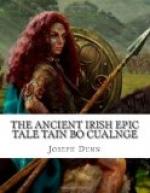Among the many poems which have taken their theme from the Tain and the deeds of Cuchulain may be mentioned: “The Foray of Queen Meave,” by Aubrey de Vere, Poetic Works, London, 1882, vol. ii, pages 255-343; “The Old Age of Queen Maeve,” by William Butler Yeats, Collected Works, vol. I, page 41, London, 1908; “The Defenders of the Ford,” by Alice Milligan, in her “Hero Lays,” page 50, Dublin, 1908; George Sigerson, “Bards of the Gael and the Gall,” London, 1897; “The Tain-Quest,” by Sir Samuel Ferguson, in his “Lays of the Western Gael and other Poems,” Dublin, 1897; “The Red Branch Crests, A Trilogy,” by Charles Leonard Moore, London, 1906; “The Laughter of Scathach,” by Fiona Macleod, in “The Washer of the Ford and Barbaric Tales”; Hector Maclean, “Ultonian Hero-Ballads collected in the Highlands and Western Isles of Scotland,” Glasgow, 1892; ballad versions from Scotland are found in Leabhar na Feinne, pages 1 and fol., in J.G. Campbell’s “The Fians,” pages 6 and fol., and in the Book of the Dean of Lismore.
Finally, scenes from the Tain have been dramatized by Canon Peter O’Leary, in the Cork “Weekly Examiner,” April 14, 1900 and fol., by Sir Samuel Ferguson, “The Naming of Cuchulain: A Dramatic Scene,” first played in Belfast, March 9, 1910; in “The Triumph of Maeve,” A Romance in dramatic form, 1906; “Cuchulain,” etc., (A Cycle of Plays, by S. and J. Varian, Dublin), and in “The Boy-Deeds of Cuchulain,” A Pageant in three Acts, performed in Dublin in 1909.




